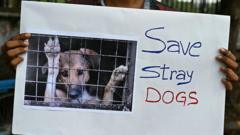In a distressing incident highlighting the challenges faced by modern zoos, a zoo in Nuremberg, Germany, has culled 12 healthy Guinea baboons, claiming overcrowding led to increased conflict among the animals. After attempts at contraception to control the burgeoning population failed, the zoo resorted to this drastic measure, whereby the culled baboons were subsequently fed to predators.
Animal rights activists reacted swiftly, with seven demonstrators arrested for entering the zoo in protest, including one woman who glued herself to the ground as a form of dissent. According to Christoph Maisack of the German Legal Association for Animal Protection Law, the rationale behind the culling — that allowing animals to breed too freely justified their execution — does not hold up under ethical scrutiny.
The Nuremberg Zoo has been grappling with overpopulation for several years, with the local baboon population exceeding 40, a significant increase over the facility's capacity of 25 set by an enclosure completed in 2009. The culling was not the zoo's first decision of this kind, as year before, plans to cull baboons were announced, reinforcing the concerns surrounding population management.
On the morning of the culling announcement, the zoo temporarily closed its gates, inciting demonstrators to breach security and protest outside. Zoo director Dag Encke expressed that such decisions were not made lightly, referring to them as a "legitimate last resort" aimed at preserving the species, as outlined by standards from the European Association of Zoos and Aquaria (EAZA).
Despite these claims, outraged animal welfare organizations have lodged criminal complaints against the zoo, asserting the culling was both avoidable and unlawful. Pro Wildlife's spokesperson stated that the zoo's longstanding "irresponsible and unsustainable breeding policies" were to blame for this tragic outcome.
This incident draws inevitable comparisons to previous controversies in Europe, including the notorious 2014 incident involving the euthanization of a genetically surplus giraffe at the Copenhagen Zoo, which was met with global outrage. The ethical implications of such actions continue to be a contentious topic within the field of animal conservation in captivity.
Animal rights activists reacted swiftly, with seven demonstrators arrested for entering the zoo in protest, including one woman who glued herself to the ground as a form of dissent. According to Christoph Maisack of the German Legal Association for Animal Protection Law, the rationale behind the culling — that allowing animals to breed too freely justified their execution — does not hold up under ethical scrutiny.
The Nuremberg Zoo has been grappling with overpopulation for several years, with the local baboon population exceeding 40, a significant increase over the facility's capacity of 25 set by an enclosure completed in 2009. The culling was not the zoo's first decision of this kind, as year before, plans to cull baboons were announced, reinforcing the concerns surrounding population management.
On the morning of the culling announcement, the zoo temporarily closed its gates, inciting demonstrators to breach security and protest outside. Zoo director Dag Encke expressed that such decisions were not made lightly, referring to them as a "legitimate last resort" aimed at preserving the species, as outlined by standards from the European Association of Zoos and Aquaria (EAZA).
Despite these claims, outraged animal welfare organizations have lodged criminal complaints against the zoo, asserting the culling was both avoidable and unlawful. Pro Wildlife's spokesperson stated that the zoo's longstanding "irresponsible and unsustainable breeding policies" were to blame for this tragic outcome.
This incident draws inevitable comparisons to previous controversies in Europe, including the notorious 2014 incident involving the euthanization of a genetically surplus giraffe at the Copenhagen Zoo, which was met with global outrage. The ethical implications of such actions continue to be a contentious topic within the field of animal conservation in captivity.





















